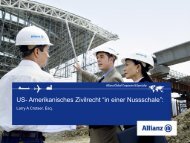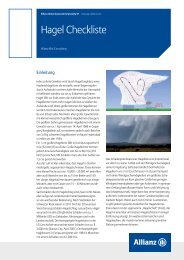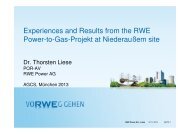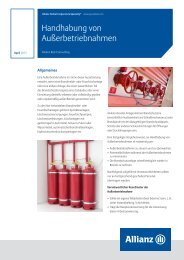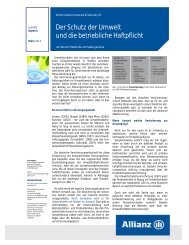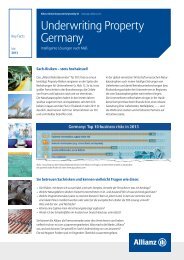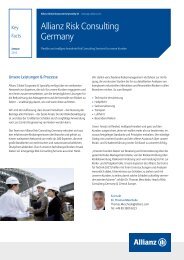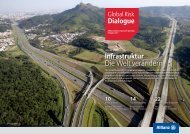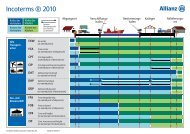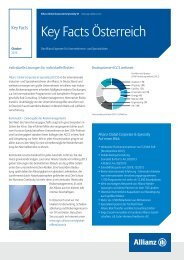Energy - Allianz Global Corporate & Specialty
Energy - Allianz Global Corporate & Specialty
Energy - Allianz Global Corporate & Specialty
Create successful ePaper yourself
Turn your PDF publications into a flip-book with our unique Google optimized e-Paper software.
RISK<br />
FUTURES<br />
A day in the life<br />
XXXXXXXXXXX<br />
Risk assessment<br />
of the Mercedes-Benz<br />
truck plant<br />
<strong>Allianz</strong> <strong>Global</strong> <strong>Corporate</strong> & <strong>Specialty</strong> has a worldwide team of risk engineers<br />
who support its clients in risk control and management of their risk. But how<br />
does a risk assessment actually work and what are the most important<br />
steps? Read a first-hand report on a risk visit at one of our large client's production<br />
plants in Wörth near Karlsruhe.<br />
ANNIKA SCHÜNEMANN<br />
In a loss-control program, it's quite common to hold a<br />
preliminary meeting the evening before things get serious.<br />
The aim is to outline the expectations of the risk<br />
engineer and customer and determine the approach for<br />
the next days is a common practice. Having met during<br />
earlier inspections, Stefan Kippert, a risk engineer at <strong>Allianz</strong><br />
<strong>Global</strong> <strong>Corporate</strong> & <strong>Specialty</strong>, and Eberhard Hess,<br />
the employee responsible for risk engineering in the<br />
property division of Daimler, have been working together<br />
for many years. The day begins at about 7:30 in the<br />
morning with a trip to Wörth. The first impression is<br />
overwhelming – with its nearly 2.5 million square meters,<br />
the plant resembles a small city. It even has its own<br />
heating supply station and wastewater-treatment faci-<br />
10 Risk Futures<br />
lity. The activities at the site are kicked off by the plant supervisor<br />
(or, in this case, a substitute for the supervisor)<br />
who greets all of the participants in the risk assessment.<br />
The Mercedes-Benz Wörth plant produces a huge variety<br />
of trucks and special-purpose vehicles such as the<br />
UNIMOG, often deployed as a municipal utility vehicle,<br />
and the Econic, frequently used as a garbage truck.<br />
Then things get serious, and the risk assessment group<br />
(consisting of the AGCS risk engineer, an employee from<br />
plant technical services, the head of plant safety and<br />
Eberhard Hess) enters the assembly line area. Stefan Kippert<br />
has inspected this plant before and thus knows<br />
exactly what to look out for. For him, the main hall is not<br />
only the heart of production, but also the core element<br />
in terms of risk management. A sprinkler system protects<br />
the entire hall from fires. But, particularly when<br />
renovating, it’s important to think about risk management<br />
and retrofit the sprinklers, especially when scaffolding<br />
remains in place for a long time. It is fascinating<br />
to observe how the engineer carefully examines exactly<br />
those places the average person would walk right past –<br />
dazzled by the appeal of the huge commercial vehicles<br />
produced here. From time to time, Stefan Kippert disappears<br />
into a machinery chamber or adjoining room,<br />
writes assiduous notes and asks the plant workers<br />
specific questions about the risk management of the<br />
various areas.<br />
Involving the risk experts early on<br />
Stefan Kippert explains: “For many new buildings,<br />
renovations and changes of use, <strong>Allianz</strong> Risk Consult ing<br />
is already involved in the planning process. This is a huge<br />
advantage because we can introduce risk management<br />
considerations early in the development process. But after<br />
this point, too, small changes such as installing<br />
smoke alarms in containers can often contrib ute to overall<br />
safety.”<br />
A significant part of production is paintwork: After<br />
assembly, the driver’s cabs are brought to the painting<br />
area where they have to show their colors. Now it gets exciting:<br />
Because of cleanliness standards, a protective<br />
Regular checks are<br />
essential at the Wörth<br />
plant, which covers<br />
almost 2.5 million<br />
square meters.<br />
Risk Futures 11





